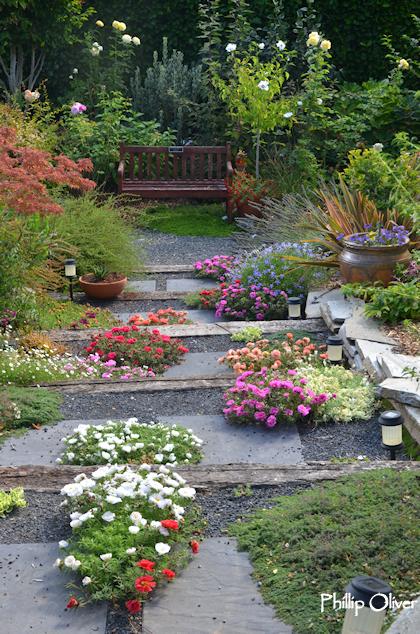I think sometimes that we gardeners take for granted the simple plants that do so well in the garden. We just plop them in the earth or a pot and forget about them as they go on their way and perform amazingly with minimal care.
I was thinking about that this morning as I pulled up a sad clump of ratty portulaca and tossed it into the compost bin. This was our second night with light frosts and while it did not do too much damage, I could definitely see that the portulaca was unhappy. It would linger on, had I left it, but the fact of the matter is that it just doesn't like these cloudy, rainy days that we've been having, much less the dipping temperatures. It prefers the sun-kissed, warmer days of August, when these photo were taken.
I've been growing this colorful annual for 30 years now and realized that it first came to my attention after I met Michael. His mother absolutely loved Moss Rose, the common name that many know it by, and one year we planted it all along the front of her sunny porch. Along with her beloved petunias and salmon gladiolous, it was a riot of color all summer long.
We grew it in our Alabama garden mostly in pots although it does perfectly fine in the ground. Pam Harper says she grew Portulaca orleacea (purslane, very similar) in sandy soil covered with gravel and used it as a lawn alternative.
I was skeptical about it doing well here in the Pacific Northwest but to my surprise, it performs beautifully. We have it in pots (I love in terra cotta bowls) and it flourishes in the new courtyard area as well as the terrace steps. The soil drains well here and is covered with gravel (thank you Pam!). The portulaca has done so well that it often pops up here and there.
This is a South America native that is known for drought tolerance and a bit of neglect. That said, we've learned that regular watering and fertilizing makes them very lush and full. The flower colors are hot and vibrant on sunny days and they begin to close up in late afternoon. On cloudy and rainy days, the plants sulk and the flowers do not open.
 |
Portulaca with Erigeron
karvinskianus 'Profusion'
|
 |
| Portulaca is very happy on the terrace steps. A few of these were planted but many were volunteers. |
 |
A pink volunteer with Sea Campion (Silene uniflora 'Druett's Variegated')
|
 |
One of the prettiest, in my opinion, has been this peach variety. I regret that
I did not keep the tag for this one.
|
 |
| Pots of portulaca are placed around our water feature in the courtyard but the Orange Sedge has quickly taken over. |
Text and photos by Phillip Oliver,
Dirt Therapy










I like the way you have separate colors. It seems that portulaca is sold in packs of mixed colors here. I used to grow it when I had a lot more sun. It is a cheerful plant.
ReplyDeleteI am surprised that you have had frost already. WOW. Here we have been having record heat and no rain. An odd year weather-wise. One for the books.
I tried Portulaca once and it did not survive--too dry, probably. Based on your photos, another attempt seems like a good idea.
ReplyDeleteI love the clumps of colors down the terrace steps. Since they are annuals, you can try new combinations and colors every year. It looks splendid on the gray slate.
ReplyDeleteI discovered years ago that Portulaca is one of the few things that will grow in some concrete urns we have. Most other plants cook and perish. But your photos have opened my eyes to other possibilities. Your terrace steps are gorgeous in bloom!
ReplyDelete